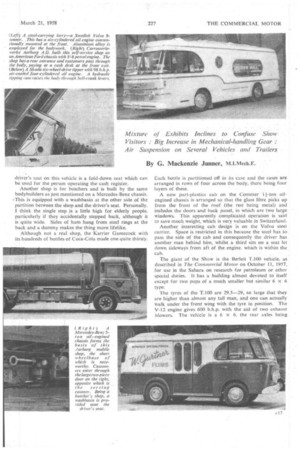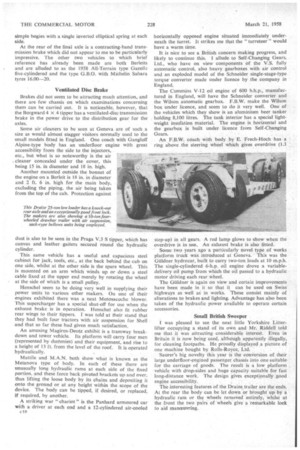Too Muc Variety at Genev
Page 52

Page 53

Page 54

If you've noticed an error in this article please click here to report it so we can fix it.
By G. Mackenzie Junner, M.I.Mech.E,
E International Motor Show at Geneva is always
popular, and that which closes on Sunday is no
exception to the rule, although the elements had not been so propitious. As usual, a great deal of stand space is occupied by the commercial contingent, but this expression is becoming very wide. Consequently, the various exhibits are mixed in a much more surprising way than they used to be in the past. Now there may be, say, an ,Aveling-Barford heavy dumper next to some very light 'vehicle, a refuse collector next door to a fine coach.
'. Probably the exhibitors think that variety is the spice of life, but it may sometimes be too pronounced. The great increase in the exhibitors of loading and unloading device,:
such as platform wagons and fork-lift trucks has made a heavy call on the space available.
What are the main points of interest in the Show so far as our readers are concerned? It is difficult to point to more than one or two that are outstanding. There are tentative efforts at air suspension and some half a dozen examples are on exhibition. One coach by Magirus has the Westinghouse system of balancing valves. This coach . was sold and the owner would not allow anyone to test it because he was afraid of having trouble before he started his first run of the season, not necessarily mechanical trouble, but possibly an accident.
Another coach, the Schindler, prOvides the alternative of single helical springs all round or air all round. The Neoplan coach of chassisiess construction with Henschel underfloor engine and automatic lubrication throughout is to have air suspension in the latest model.
The largest semi-trailer in the Show, a D.A.F., has four wheels on swinging arms which act on double-bag air
springs made in Holland. •Draize also use the Westinghouse system and their 10-ton trailer uses two rubber bags about 18 in. long by 5 in. deep. The pressure in these is said to
be 3-4 atmospheres.
Mobile shops are becoming more popular; the smallest, but a very neat one, is a coffee bar on a metalpanelled Citroen. The most striking is an American-built Ford with V-8 engine bodied by Aarburg Coachworks as a high-speed, selfservice shop. It is capable of 70 m.p.h., although why this should be necessary is doubtful, unless it is to catch the markets early and replenish quickly. At the back of the driver's seat on this vehicle is a fold-down seat which can be used for the person operating the cash register.
Another shop is for butchers and is built by the same bodybuilders as just mentioned on a Mercedes-Benz chassis. -This is equipped with a washbasin at the other side of the partition between the shop and the driver's seat. Personally. I think the single step is a little high for elderly people, particularly if they accidentally stepped back, although it is quite wide. Sides of ham hang from steel rings at the back and a dummy makes the thing more lifelike.
Although not a real shop, the -Karrier Gamecock with its hundreds of bottles of Coca-Cola made one quite thirsty.
Each bottle is partitioned off in its case and the cases are arranged in rows of four across the body, There being four layers of these.
A new part-plastics cab on the Commer if-ton oil. engined chassis is arranged so that the glass fibre picks up from the front of the roof (the rest being metal) and includes the doors and back panel, in which are two large windows. This apparently complicated operation is said to save much weight, which is very valuable in Switzerland.
Another interesting cab design is on the Volvo steel carrier. Space is restricted in this because the steel has topass the side of the cab and consequently the driver has another man behind him, whilst a third sits on a seat let down Sideways from aft of the engine, which is within the cab. •
The giant of the Show is the Berleit T.100 vehicle, as described in The Commercial Motor on October 11, 1957, for use in the Sahara on research for petroleum or other special duties. It has a building almost devoted to itself except for two pups of a much smaller but similar 6 X 6 type.
The tyres of the T.100 are 29.5-29, so large that they are higher than almost any tall man, and one can actually walk under the front wing with the tyre in position. The V-I2 engine gives 600 b.h.p with the aid of two exhaust blowers. The vehicle is a 6 X 6, the rear axles being simple bogies with a single inverted elliptical spring at each side.
At the rear of the final axle is a contracting-band transmission brake which did not appear to me to be particularly impressive. The other two vehicles to which brief reference has already been made are both Berleits and are alluded to as the 1958 All-Terrain type Gazelle five-cylindered and the type G.B.O. with Michelin Sahara tyres 16.00-20.
Ventilated Disc Brake
Brakes did not seem to be attracting much attention,. and there are few chassis on which examinations concerning them can be carried out. It is noticeable, however, that the Borgward 4 X 4 tipper has a ventilated-disc transmission brake in the power drive to the distribution gear for the axles.
Some air cleaners to be seen at Geneva are of such a size as would almost stagger visitors normally used to the small models fitted in England. One coach with Gangloff Alpine-type body has an underfloor engine with great accessibility from the side to the injectors, etc., but what is so noteworthy is the air . cleaner concealed under the cover, this being 15 in. in diameter and 18 in. high.
Another mounted outside the bonnet of the engine on a Berleit is 18 in. in diameter and 2 ft. 6 in. high for the main body, excluding the piping, the air being taken from the top of the cab. Protection against dust is also to be seen in the Praga V.3 S tipper, which has canvas and leather gaiters secured round the hydraulic cylinder.
This same vehicle has a useful and capacious steel cabinet for jack, tools, etc., at the back behind the cab on one side, whilst at the other side is the spare wheel. This is mounted on an arm which winds up or down a steel cable fixed at the upper end merely by rotating the wheel at the side of which is a small pulley.
Henschel seem to be doing very well in supplying their power units to various other makers. On one of their engines exhibited there was a neat Motosacoche blower.
This supercharger has a special shut-off for use when the exhaust brake is in operation. Henschel also fit rubber rear wings to their tippers. I was told at their stand that they had built four tractors with air suspension for Shell and that so far these had given much satisfaction.
An amusing Magirus-Deutz exhibit is a tramway breakdown and tower vehicle. Its platform will carry four men (represented by dummies) and their equipment, and rise to a height of 13 ft. from the level of the roof. It is operated hydraulically.
Mattile and M.A.N. both show what is known as the Metanova type of body. In each of these there are unusually long hydraulic rams at each side of the fixed portion. and these force back pivoted brackets up and over, thus lifting the loose body by its chains and depositing it onto the ground or at any height within the scope of the device. The body can be tipped, if desired, or replaced, if required, by another.
A striking war " chariot " is the Panhard armoured car with a driver at each end and a 12-cylindered air-cooled c18 horizontally opposed engine situated immediately underneath the turret. It strikes me that the " turreteer " would have a warm time.
It is nice to see a British concern making progress, and likely to continue this. I allude to Self-Changing Gears, Ltd., who have on view components of the V.S. fully automatic control, also heavy gearboxes with air control and an exploded model of the Schneider single-stage-type torque converter made under licence by the company in England.
The Cummins V-12 oil engine of 600 b.h.p., manufactured in England, will have the Schneider converter and the Wilson automatic gearbox. F.B.W. make the Wilson box under licence, and seem to do it very well. One of the vehicles which they show is an aluminium beer tanker holding 8,100 litres. The tank interior has a special lightweight insulation material. The engine is horizontal and the gearbox is built under licence from Self-Changing Gears.
An F.B.W. coach with body by E. Frech-Hoch has a ring above the steering wheel which gives overdrive (1.3 step-up) in all gears. A red lamp glows to show when the overdrive is in use., An exhaust brake is also fitted.
Some two years ago a particularly novel type of works platform truck was introduced at Geneva. This was the Gifidner hydrocar, built to carry two-ton loads at 10 m.p.h. The single-cylindered 6-h.p. oil engine drove a variabledelivery oil pump from which the oil passed to a hydraulic motor driving each rear wheel.
The Guldner is again on view and certain improvements have been made in it so that it can be used on Swiss highways as well as in works. These consist mainly of alterations to brakes and lighting. Advantage has also been taken of the hydraulic power available to operate certain accessories.
Small British Sweeper
was pleased to see the neat little Yorkshire Litterlifter occupying a stand of its own and Mr. Riddell told me that it was attracting. considerable interest. Even in Britain it is now being used, although apparently illegally, for cleaning footpaths. He proudly displayed a picture of one machine bought by Rolls-Royce, Ltd.
Saurer's big novelty this year is the conversion of their large underfloor-engined passenger chassis into one suitable for the carriage of goods. The result is a low platform vehicle with drop-sides and huge capacity suitable for fast long-distance work. The design gives exceptionally good engine accessibility.
The interesting features of the Draize trailer are the ends. At the rear the body can be let down or brought up by a hydraulic ram or the wheels removed entirely, whilst at the front the two pairs of wheels give a remarkable lock to aid manceuvring.








































































































